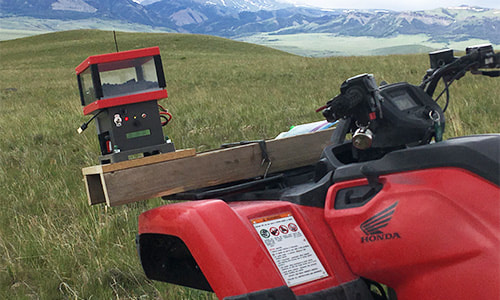Disease Mitigation in Prairie Dogs and Black-Footed Ferrets
|
Project Title:
Assembling a safe and effective toolbox for integrated plague mitigation and wildlife conservation Project Collaborators: U.S. Geological Survey Prairie Wildlife Research National Park Service U.S. Forest Service U.S. Fish and Wildlife Service Centers for Disease Control and Prevention World Wildlife Fund Lower Brule Sioux Tribe Arizona Game and Fish Department Colorado State University Turner Endangered Species Fund U.S. Department of Agriculture-APHIS |
In the grasslands of western North America, plague poses one of the most significant biological challenges to the conservation of black-footed ferrets (BFF) and prairie dogs. Deltamethrin dust, a pulicide for controlling the fleas that spread plague in prairie dog populations has been a mainstay of BFF conservation for decades. That said, experiments conducted by the U.S. Geological Survey (USGS) and many collaborators has demonstrated, fleas can develop resistance to deltamethrin and may have unintended, negative impacts on some non-target species. Over the past decade, USGS and colleagues have evaluated >15 tools for flea control. Encouragingly, an edible grain bait targeting prairie dogs and laced with fipronil (most widely known as the active ingredient of Frontline flea treatment for dogs and cats), proved effective in controlling prairie dog fleas for 1-2 years or longer in some cases. The FWS, USGS, and colleagues are continuing to evaluating different active ingredients used to control fleas and ticks on dogs and cats to develop a toolbox of treatment methods for plague management in prairie dog populations. Rotating active ingredients should prevent fleas from developing resistance to any one active ingredient.
|
Project Title:
Flea control with FipBits to prevent plague from killing black-footed ferrets and their prairie dog prey Project Collaborators: U.S. Fish and Wildlife Service U.S. Geological Survey Arizona Game and Fish Department Prairie Wildlife Research BASF Colorado State University World Wildlife Fund Model Avionics Buffalo Gap National Grasslands Badlands National Park Smithsonian Conservation Biology Institute American Prairie Turner Endangered Species Fund |
The primary biological challenge to recovery of endangered black-footed ferrets is sylvatic plague, caused by the bacterium Yersinia pestis, and vectored primarily by fleas. Flea control with insecticides on prairie dog colonies is generally effective in preventing plague, but is expensive (~$30/acre) to conduct annually and fleas can develop insecticide resistance. The U.S. Fish and Wildlife Service developed a new bait pellet (FipBits) that contains tiny amounts of fipronil (the active ingredient in Frontline spray used for a long time to topically control fleas and ticks on dogs and cats). Adult fleas that feed on prairie dogs that consumed a FipBit are killed and flea larvae that feed on feces from prairie dogs that ate FipBits are also killed. Flea control has been exceptional for one year post-treatment, and for two years in some cases, after a single treatment of 50 FipBits/acre (2.2 ounces of FipBits/acre). Flea/plague control costs using FipBits may be reduced by 90% or more compared to current methods. With regulatory agency approvals, FipBits may become a “game-changer” in the battle against plague in support of black-footed ferret recovery.
Black-footed Ferret Monitoring Techniques
|
Project Title:
UAVs as a tool for detecting the endangered Black-footed Ferret Project Collaborators: Steller's Jay Solutions, LLC Fort Belknap Fish and Game Department Idaho State University World Wildlife Fund Little Dog Wildlife |
|
The conservation and management of black-footed ferrets has traditionally relied on nocturnal spotlight surveys to detect, count, and assess reintroduced populations throughout North America. Although spotlight surveys are considered to be the most effective method for detecting black-footed ferrets, researchers are interested in exploring alternative methods for monitoring populations. One method that has recently been found to hold promise as a potential tool is the use of unmanned aerial vehicles (UAVs, also-known-as drones) equipped with thermal cameras. Recent advances in UAV and camera technologies have resulted in a survey tool capable of detecting small-bodied wildlife during nighttime flights. In 2022, researchers put these technologies to the test in a pilot study at the Fort Belknap Reservation in Blaine County, Montana, where a reintroduced ferret population currently resides. In this first-of-its-kind study, researchers were able to clearly detect black-footed ferrets moving aboveground during the night from a UAV equipped with a thermal camera.
We are working to populate this page with more research articles in the near future. Please check back soon for additional information.




